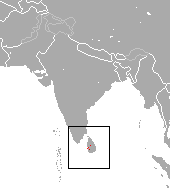
The Brown-headed barbet is an Asian barbet species native to the Indian subcontinent, where it inhabits tropical and subtropical moist broadleaf forests. It is widespread, with its range stretching from the Terai in southern Nepal in the north to Sri Lanka in the south, encompassing most of peninsular India, and listed as Least Concern on the IUCN Red List. It is an arboreal species of gardens and wooded country which eats fruit and insects. It is fairly tolerant of humans and often seen in city parks. It nests in a tree hole, laying 2-4 eggs. It forages on mangoes, ripe jackfruit, papaya, banana, figs and similar cultivated fruit trees. Its habitat includes urban and country gardens; it tends to eschew heavy forest. It nests in a suitable hole in a tree that it will often excavate. Both sexes incubate the eggs and often communicate with each other using their Kura, kura calls.

The broom hare is a species of hare endemic to northern Spain.

The Asian house shrew is a shrew species native to South and Southeast Asia that has been listed as Least Concern on the IUCN Red List since 2008 because of its large population and wide distribution. It has been introduced in several West Asian and East African countries. It is considered an invasive species and implicated in the demise of several island lizard species.

Anderson's four-eyed opossum is an opossum species from South America. It is found in Brazil, Colombia, Ecuador, Peru and Venezuela. Its dorsal fur is dark, with a black stripe, about 3–4 cm wide, going vertically down the midline of its back. Its dorsal fur is short, about 10 mm long. Its ventral fur is dark gray, but still distinctly lighter than the sides and dorsum. Its tail is furred for the first (approximately) 18% of its length, going from the base to the tip. Its species name "andersoni" was chosen to honor American scientific collector Malcolm Playfair Anderson.

The black-fronted duiker is a small antelope found in central and west-central Africa.
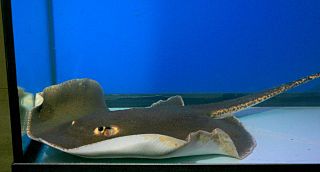
The roughback whipray is a rare species of freshwater stingray in the family Dasyatidae, found over sandy bottoms in the Mae Klong and Chao Phraya Rivers of Thailand. Growing no more than 29 cm (11 in) across, this small ray has an oval pectoral fin disc and a whip-like tail without fin folds. It closely resembles the white-edge freshwater whipray in appearance, but can be distinguished by its coloration: light gray to dark orange-brown above and white below with a dark band along the lateral margins. Another identifying feature is a "pearl organ" at the center of the back, found in individuals of all ages. All of the original specimens of the roughback whipray were found with extensive wounds to the fins and tail. The International Union for Conservation of Nature (IUCN) has assessed this species as Endangered, citing the extensive habitat degradation and heavy fishing pressure within its limited range.

The pale-billed sicklebill is a species of sicklebill that belongs to the family Paradisaeidae, which contains the renowned birds-of-paradise.

Tickell's bat is a species of vesper bat. It can be found in the following countries: Bangladesh Bhutan, Cambodia, possibly China, India, Myanmar, Nepal, Sri Lanka and Thailand.

The purple-bellied lory is a species of parrot in the family Psittaculidae. It is endemic to Papua New Guinea. It is found in south-east New Guinea, the Bismarck Archipelago, the d'Entrecasteaux Islands, the Louisiade Archipelago, the Trobriand Islands and Woodlark Island.
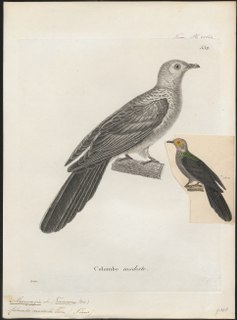
The black cuckoo-dove, also known as the slaty cuckoo-dove, is a species of bird in the family Columbidae. It is endemic to the Lesser Sunda Islands, being found on Timor, Wetar, Rote, and Atauro. It inhabits primary and secondary monsoon forest, eucalyptus forest, and woodlands. It is 38.5 cm (15.2 in) long on average, and is mainly dark bluish-gray, lighter on the head and underparts and darker on the wings and tail. It has yellow orbital skin.
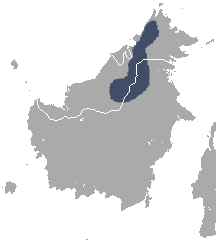
The Bornean smooth-tailed treeshrew is a species of treeshrew in the family Tupaiidae. It is endemic to Borneo. Its natural habitat is subtropical or tropical dry forests. It is threatened by habitat loss.

The Sri Lankan long-tailed shrew is a species of mammal in the family Soricidae. It is endemic to Sri Lanka where it is known, in Sinhala, as ශ්රී ලංකා කුනු හික් මීයා. It is threatened by habitat loss.

Pearson's long-clawed shrew is a species of mammal in the family Soricidae. It is monotypic within the genus Solisorex. It is endemic to Sri Lanka. Its natural habitats are subtropical or tropical dry forests and subtropical or tropical dry lowland grassland. It is threatened by habitat loss. It is known as ශ්රී ලංකා නියදිගු මා හික් මීයා in Sinhala.

The Sri Lankan shrew, also called Gordon's pygmy shrew, is a species of mammal in the family Soricidae. It is endemic to Sri Lanka. It is threatened by habitat loss. It is known as හික් මීයා in Sinhala. It was named after the wife of A. C. Tutein-Nolthenius, Marjory née Fellowes-Gordon, who collected specimens of the shrew and provided them to Phillips.

The Asian highland shrew is a species of mammal in the family Soricidae. It is found in India and Sri Lanka. Its habitat is subtropical or tropical dry forests. It is threatened by habitat loss. It is known as ශ්රී ලංකා කදු හික් මීයා in Sinhala.
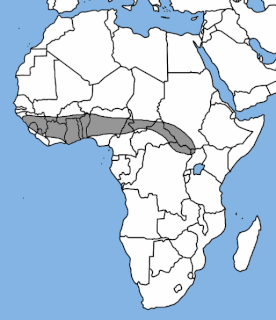
The Aba roundleaf bat, also known as the Aba leaf-nosed bat is a species of bat in the family Hipposideridae. It is found in west Africa along the southern coast from Nigeria to Senegal. Populations have also been noted in Sudan and Uganda. Its natural habitats are subtropical or tropical moist lowland forests, dry savanna, moist savanna, and caves.

The black jackrabbit is a species of mammal in the family Leporidae. Endemic to Mexico, its only known location is Espiritu Santo Island in the Gulf of California. The IUCN has listed this species as a "vulnerable species" because of its restricted range. This taxon is regarded by some authorities as being a subspecies of the black-tailed jackrabbit, found on the mainland of Mexico.
The Hortle's whipray is a little-known species of stingray in the family Dasyatidae, occurring in shallow estuaries and mud flats off southern New Guinea. This species, growing to 71 cm (28 in) across, has a heart-shaped pectoral fin disc with a long, pointed snout and minute eyes. It has a wide dorsal band of dermal denticles extending from in front of the eyes to the tail, as well as scattered sharp denticles on the snout. The underside of the disc is a distinctive bright yellow in color, sometimes with darker markings around the nostrils, mouth, and gill slits. The Hortle's whipray is threatened by extensive seine fisheries and habitat degradation, leading the International Union for Conservation of Nature (IUCN) to assess it as Near Threatened.

Petter's big-footed mouse, is a Madagascan rodent in the genus Macrotarsomys. With a head and body length of 150 mm (5.9 in) and body mass of 105 g (3.7 oz), It is the largest species of its genus. The upperparts are brown, darkest in the middle of the back, and the underparts are white to yellowish. The animal has long whiskers, short forelimbs, and long hindfeet. The tail ends in a prominent tuft of long, light hairs. The skull is robust and the molars are low-crowned and cuspidate.
